Durham Cathedral & City of York
Well, we finally did it! We planned too much in too little time: three days of travel to do in just two. Still we saw some wonderful sights. Day 1 consisted of Durham Cathedral and the city of York. Enjoy these pictures.
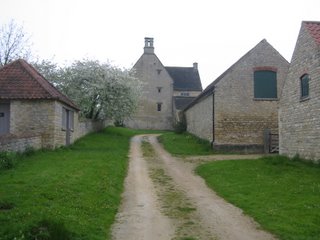
During our 4.5 hour trip to Durham we took a little detour off the A1 in Lincolnshire to see Isaac Newton's childhood home at Woolsthorpe Manor. Unfortunately we could only take photographs from the gate as the facility was closed on Mondays.

From these pictures you can tell that he came from a relatively well-off family.

For the entire two-day trip, these fields could be seen all up and down the highways of England. The yellow of these flowers was so bright at times that it actually was hard to look at.

This pictures shows another surprise that awaited us. Driving through Nottinghamshire, we skirted along the REAL Sherwood Forest, of Robin Hood fame. Is that one of his merry men hiding in the trees?

In the city of Durham we parked by the River Wear (pronounced weer). The castle and cathedral lie on a peninsula surrounded by this river.

This was our first view of Durham Cathedral which lies atop a hill overlooking Durham proper.

Here is one of the cathedral's three towers. It is too bad that we have only a small number of photos of the interior: we were not permitted to take pictures inside the cathedral, but sneaked a couple anyway! Inside we were able to see the shrines of St. Cuthbert, the 7th century shepherd monk and bishop who helped to restore Roman practices to the Celtic Christians of Northumbria, and his contemporary, the Venerable Bede, the great early historian of England and Doctor of the Church. We have a few shots of the latter below.

This shows the Prior's Door leading from the Cloisters to the Cathedral.
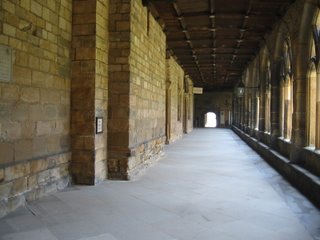
This picture shows one of the four cloister hallways. There were ceiling bosses here, but they weren't nearly as spectacular as those at Norwich.

In this beautiful picture we are standing in one of the cloister hallways, looking up at the other two towers which are a part of the Lady Chapel.

Here is another view of the cloisters.

Originally, this building was part of the kitchen, which included a vaulted wine cellar. Now it houses the restaurant as well as the Treasures of St. Cuthbert exhibition.

This picture is of the central tower as seen from the cloisters.

The hall with this lovely timbered ceiling was formerly the Monk's Dormitory (14th cent.). Now it contains the modern book collection.

The Galilee Chapel, otherwise known as the Lady Chapel, was built in 1175 and was the only place where women could worship in the cathedral at that time. Pictured here is the tomb of Bede.

Behind the altar of the Lady Chapel are twelfth century wall paintings of St. Cuthbert and St. Oswald.
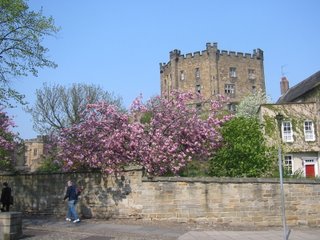
Across the square from the Cathedral sits Durham Castle, whose tower is pictured here. It now houses parts of the University of Durham.

Here is the main gate into the castle grounds.

Another view of the wall and side gate. Notice the crosses etched in the wall.

Here is a closeup of the blossoms of the beautiful tree just inside the wall of the castle in the photo above! You can see the castle tower through its branches.
 Our two-hour drive from Durham to York was spent admiring the countless fields of yellow that surrounded us.
Our two-hour drive from Durham to York was spent admiring the countless fields of yellow that surrounded us.
Our first destination in York was Clifford's Tower, pictured here. Originally it was part of a military fortification. The tower is all that's left.

Here's a good view of the inside of the tower. We were able to climb the stairs to the top to get a 360-degree view of the city of York.

This view from the walkway atop Clifford's Tower is of the Crown Court. The Castle Museum is off to the left of this picture.

This shows you how large York Minster really is. It towers above the other buildings in the city. We would be going there tomorrow morning.
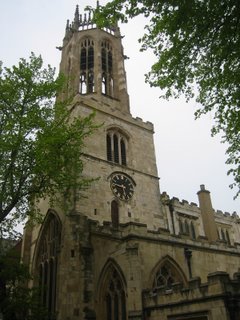
As we walked along the city streets, we found several lovely old churches. This one is All Saints.
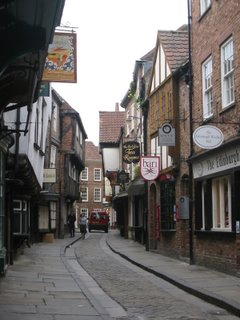
We were told not to miss this street: it's the Shambles, perhaps the best example of a medieval street in England. Look how the buildings lean in to each other.

The remarkable white house in this picture is home to a shrine to the martyred St. Margaret Clitherow, the Catholic wife of a butcher, arrested for sheltering a priest by Henry VIII's men and put to death by being pressed under great weights piled upon her on the Ouse Bridge.
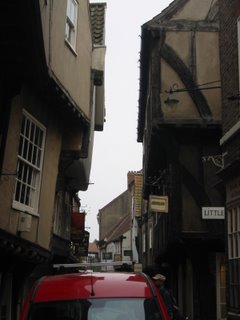
You can really see how close together the houses are here. It would be possible for neighbors across the street to shake hands with each other from window to window.

This is the Church of St. Martin Le Grand. It is now dedicated to military victims of war.

This is the side gate to St. Martin Le Grand.

Here is the nave of the present church. It is the side aisle of all that remains of the original church that sat on this site.

The great west window of the church, dedicated to St. Martin of Tours, was moved to the wall across from the entrance. It was situated across from the main entrance.

Since it was too early for us to eat and too late to make it into any of the museums, we just kept walking. Here is a photo of the River Ouse (pronounce 'ooze') facing Ouse Bridge.

We ate dinner at the famous Betty's tea rooms, across from St. Helen's church. St. Helen was the mother of the Roman emperor Constantine the Great, who was declared emperor here in York. Thank you, Fra' Lawrence, for the recommendation!

Mansion House, the Georgian home of York's mayor, lies directly across St. Helen's Square from the church.

On the way back to the car we passed this gorgeous Victorian building, the York Magistrate's Court.
After a long day of driving and much sightseeing, we made our way to the hotel for the night. Tomorrow would be another very busy day.

1 Comments:
Glad you enjoyed Betty's! The lovely yellow flowers have a rather unfortunate name: "rape". It is an agricultural crop and rapeseed oil has many interesting applications!
See: http://en.wikipedia.org/wiki/Rapeseed
Sorry you didn't have time to visit Ampleforth Abbey as well though!
Post a Comment
<< Home